Exhibition place:Textile Conservation Gallery
Exhibition time:2023.6 - 2023.8
Sponsored by the China national silk museum and the Museum of Applied Arts, Budapest, Hungary
Introduction
The most important material used in luxury textile arts is silk, which also played a major role in the history of Hungarian fashion. As Hungary did not produce its own, imported silk was used for ceremonial attire and liturgical vestments from the 10th century onwards.
In the 16th century, the Kingdom of Hungary was split into three parts due to the Ottoman Turkish conquest: Royal Hungary in the north-west, the Principality of Transylvania in the east, and the conquered territories in the middle. Trade and diplomacy brought many Turkish silk textiles to the central and eastern areas during the 16th and 17th centuries.
The northwestern part of the country, which was at war with the Ottomans, was governed by the palatines of Hungary, who were loyal vassals of the Habsburg kings. The aristocracy in these areas tended to favor Italian silks, although they sometimes purchased materials from France or Spain, while Turkish and Persian silks were also highly prized.
Expensive silk garments, worn by men and women alike, can often be found listed in inventories from this period, although only a few managed to survive the following centuries. Most important among them are the garments from the treasury of Count Miklós Esterházy (1583–1645) and his son, Prince and Palatine Pál Esterházy (1635–1713).
The Esterházy collection, which weathered the storms of history at the family castle in Fraknó (now Forchtenstein, Austria), preserved an unparalleled series of men’s vestments, a few women’s dresses, and some of the luxury textiles used as palace decorations.
For the last century, these textiles have been held by the Museum of Applied Arts in Budapest. Having suffered severe damage in World War II, most of the treasury goods have since been restored, and the collection faithfully represents the diversity and opulence of this historical Hungarian aristocratic treasury.
The ornate garments worn by the male members of the Esterházy family or revered as ancestral relics were tailored using the most highly prized silks and silk velvets from Italy, Spain, and Türkiye, and then richly decorated with goldsmiths’ work, jewels and pearls. The selection also includes quilts and covers sewn from precious silks or decorated with heraldic symbols, as well as ceremonial attire, weapons, and weapon cases.
This exhibition presents highlights from the textiles held by the Esterházy Treasury focused on 16th and 17th century items made with the most valuable silk fabrics, which offer insight into the lifestyle of Hungarian noblemen of the time, from fashion and celebrations, to home decorations and military traditions.

Portrait of Count Miklós Esterházy, 1645
copyright Budapest, Hungarian National Museum, Historical Portrait Gallery,
Collection of Miklós Jankovich
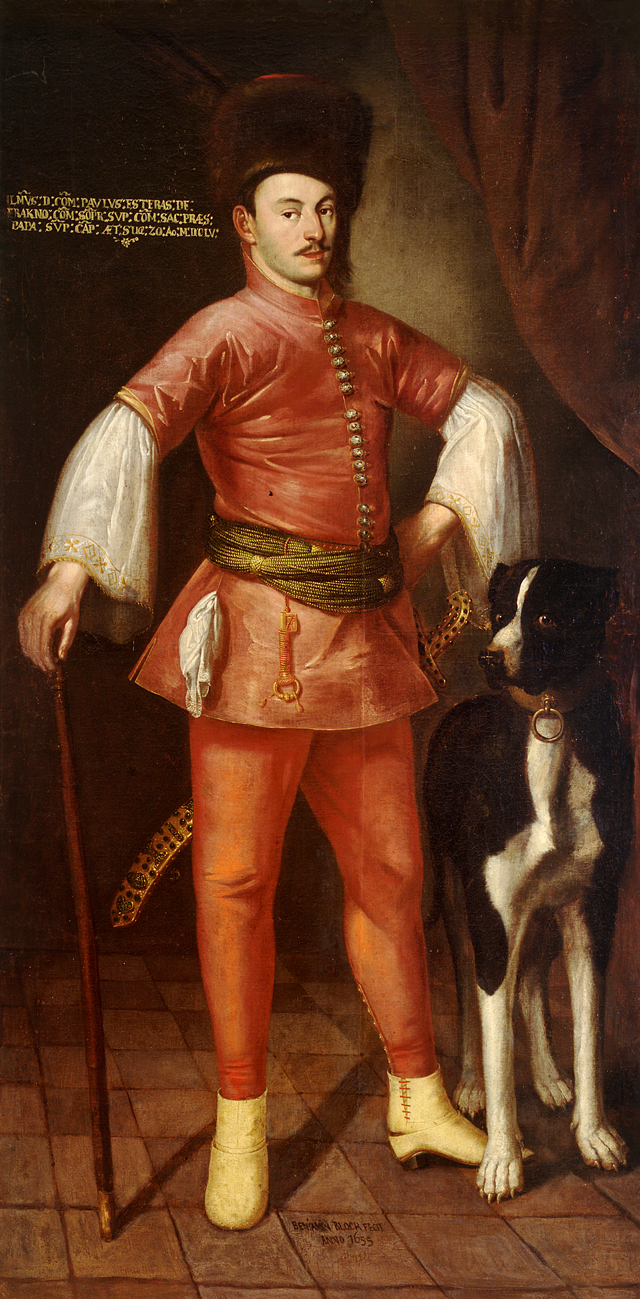
Portrait of Count (later Prince) Pál Esterházy, 1655
copyright Eisenstadt, Esterházy Foundation,
Forchtenstein Castle, Esterházy Gallery of Ancestors
1.Men’s garments
The etiquette and fashion of the Spanish royal court gave Europe a pattern to follow in the 16th and 17th centuries. Royalty and nobles dressed accordingly, as did the wealthier citizenry. Hungarian noblemen’s garments, however, preserved some traditional oriental features, since the expensive textiles, golden lacing, and fur of the garments, as well as the bejeweled accessories, fur caps and belts symbolized not only high social status and wealth, but, above all, national identity.
A man’s suit comprised two kinds of coat: a short fur-lined upper coat (mente) and the dolman (dolmány), worn directly over the shirt. The latter, woven from cotton and silk fabrics, velvet or broadcloth, was worn depending on the weather and on the rank of the wearer. Both longer, half shin-length, and shorter, hip-length versions were worn, and they were bound at the waist with gold and silver-adorned or silken-braided belt cords.
The long, thick winter upper coats woven from broadcloth or velvet were lined with fur, while the summer versions were lined with silk or cotton textiles. The tailoring of the sleeves varied, the most attractive and perhaps the most popular being a pipe sleeve hanging down to the bottom of the upper coat, although there were also elbow- and wrist-length versions.
The close-fitting leg of the Hungarian nobleman’s trouser would be visible beneath the upper coat, tucked into a kind of colored leather stocking, metal-heeled slippers or boots. The plumed cap of pine marten fur was an emblem of elevated rank, which commoners and peasants were forbidden from wearing.

Undercoat (dolman) from the wardrobe of Palatine Pál Esterházy (Cat. 5)
Italian silk fabric and lining, Hungarian tailoring and decoration; c. 1680
Atlas silk; silver and gilded silver thread, gilded silver wire, and ribbon braid; enameled clasps
L: 98 cm
The entire surface of the dolman is covered with braids of various thicknesses, made by various techniques, using silver-gilt and silver thread, silver-gilt and silver wire (scofium), and precious-metal lamella. The front of the dolman is fastened by eight enameled clasps: a white hand extending from a heart with a blue center and a white flower hold a half-heart enclosing a tulip. A red-beaked white dove with gold wings perches upon each heart and hand. When the dolman is fastened, the halves join to make whole hearts, and the doves face each other.
The dolman has been regarded in the literature as the wedding outfit of Miklós Esterházy (1612, 1624). Neither of these dates complies with the lush Baroque decoration, or the similarity in cut and size of the other dolmans in the treasury. It is likely that the outfit was worn by Pál Esterházy on his marriage to Éva Thököly in 1682.
Inv. no. 52.2804
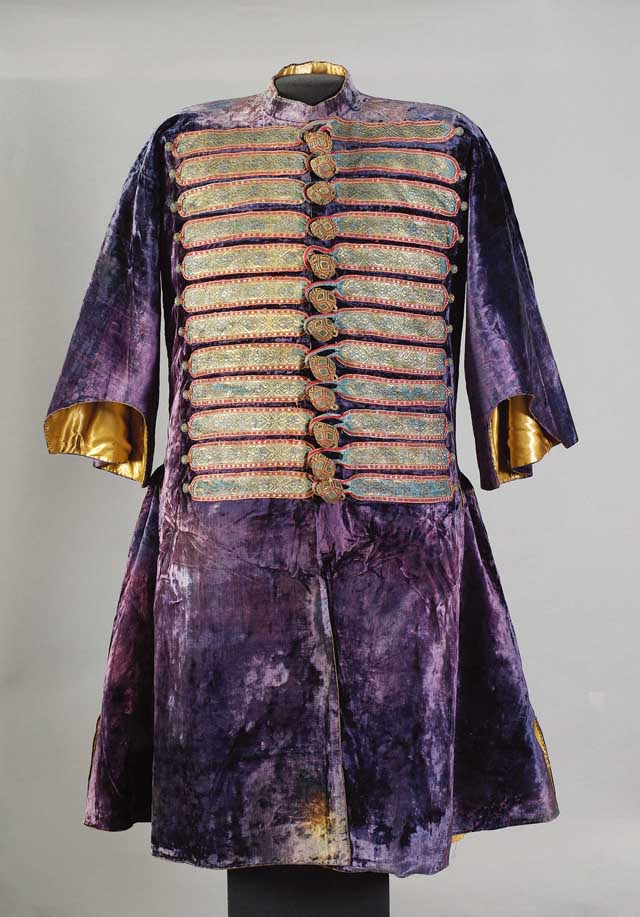
Upper coat (mente) from the wardrobe of István Esterházy (Cat. 10)
Italian velvet, Hungarian tailoring and buttonmaker’s work; c. 1640
Velvet; card-woven button stems; buttons of silk and gold-colored wire (scofium); former lynx lining replaced with silk
L: 112 cm
The tailoring is similar to the green velvet mente in the collection (Cat. 9), differing only in the standing collar and sleeves. The collar is cut along the grain, the sleeve is “Turkish.” The distinctive feature of the waist-length sleeves is the curve in the inner side. Such a design is very common in Turkish costume. On the front of the mente are twelve card-woven “buttoned band” fasteners; these too are similar to those on the green mente in the collection (Cat. 9).
It passed into the treasury of Pál Esterházy in the same way as the green upper coat.
Inv. no. 52.2771
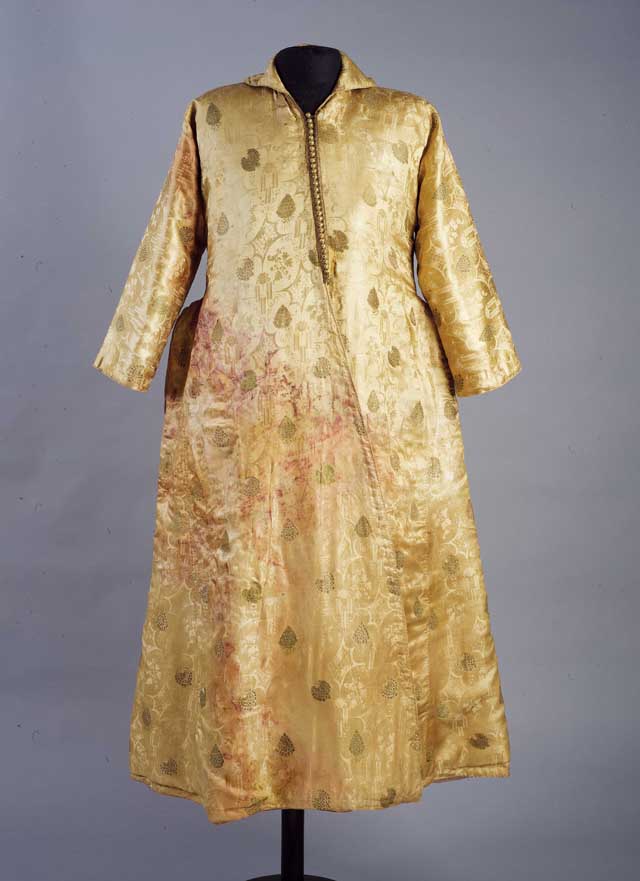
Summer upper coat (mente, kaftan) (Cat. 3)
Italian silk fabric, 1660–1670
Originally light red now faded yellow lampas liseré; brocaded with silver-gilt thread and polychrome silk thread; fastens with filigree silver-gilt buttons and gold-thread plaited loops; the lining of cotton wadding and linen is a replacement
L: 135 cm
Straight shoulders, rounded at the hips, lower part widens to the bottom. Funnel-shaped half-length sleeves. Cut obliquely at the front on both sides, selvage on the side of the garment. This aspect of the cut differs from the Hungarian mente and is similar to Turkish kaftans.
The outfit probably came into the treasury as the gift of King John III Sobieski of Poland (r. 1674–1696).
2. Horse apparel, horse tack, weapons, and weapon cases
The trappings of the horse, or “horse apparel,” as they were once known, held a special place in the treasury of a 16th–17th-century Hungarian nobleman. The number of horses, and the quality and quantity of their tackle and accoutrements, were an indication of the rank and wealth of their owner.
The Esterházy Treasury is particularly rich in Ottoman Turkish objects of first-rate quality. Among these valuable objects, all richly embroidered with gold and silver threads, are especially impor¬tant.
The saddles kept in the treasury vary in form. Apart from one Hungarian and two West European examples, they are all of Turkish origin.
The Hungarian general name for saddlecloths, cafrag, derives from the Ottoman Turkish çaprag. The rectangular cloths, decorated wholly or partly with embroidery and bordered with tassels, were spread over the horse’s hindquarters. The so-called “heavy embroidery,” using gold or silver thread (scofium), was carried out by men. The most expensive variety of saddlecloth or quiver was the fully embroidered type, where the entire surface was covered with gold and silver embroidery.
Of the two Turkish caparisons (yancık) kept in the treasury, one is made in the form of armor for a horse (barding).The treasury’s once-rich stock of weaponry and weapon cases is represented today by a few ornamental pieces, a ceremonial dagger, three ceremonial sabers, two ceremonial maces, six Turkish bow and arrow quivers, and a pair of ceremonial stirrups.
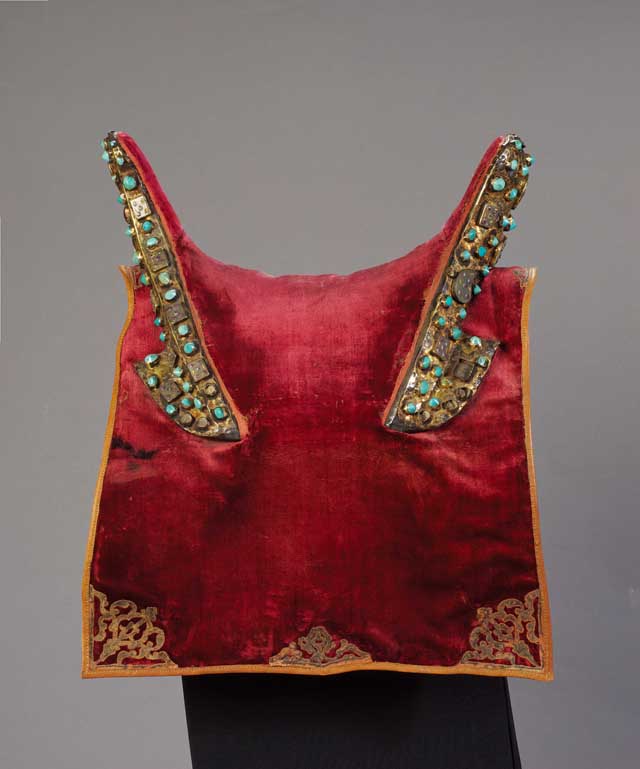
Ceremonial Saddle (Cat. 18)
Istanbul, second quarter of the 17th century – authentication marks (tuğra) of Sultan Murad IV (r. 1623–1640) on the back right and front left of the saddle boards
Wood, leather, velvet, leather appliqué and silver-gilt wire; chased, engraved and embossed silver-gilt sheet; turquoises, rubies, and nephrites
H: 55 cm, W: 50 cm, D: 50 cm
This saddle – richly decorated with silver-gilt and precious stones – represents a fine example of the two-pommel Ottoman Turkish saddles fashionable in the 1620s and 1630s. The front pommel has a long, narrow neck terminating in a bosset grip, and the back pommel is lower and stockier. The short, narrow seat is augmented with rectangular velvet-covered saddle skirts, decorated with leather appliqué with arabesque patterns embroidered in silver-gilt wire.
Inv. no. 52.2858.1
3. Home furnishings
The textiles used to richly adorn the living rooms of a 16th–17th-century Hungarian nobleman are known collectively as the home furnishings.
The fashion was to adorn the walls in the rooms of the lord and lady’s residence – especially for festive occasions – with tapestries or carpets. Woven wool or silk tapestries have unfortunately not survived in the Esterházy Treasury. Its collection of ten items in this category now contains only bed and table covers, a unique Persian silk tapestry, and a Turkish prayer rug embroidered on broadcloth.
Bedspreads made of layers of different materials, colors and patterns are known as quilts. Winter quilts were stuffed with wadding, while thinner, unfilled versions were used in the summer. Richly embroidered bedspreads decorated with coats of arms were found only in the homes of the nobility. They were made by embroiderers and pearl-threaders taken into the domestic service of princely and noble households.
The period concerned was the heyday of Hungarian noble embroidery. The square or rectangular silk or velvet coverings were generally decorated with symmetrical patterns of flowering shrubs or roots embroidered with metal thread, diagonally arranged from the corners towards the center, which were often emblazoned with a coat of arms. Designs branching out from the center to fill the entire surface or patterns of scattered flowers occur more rarely.
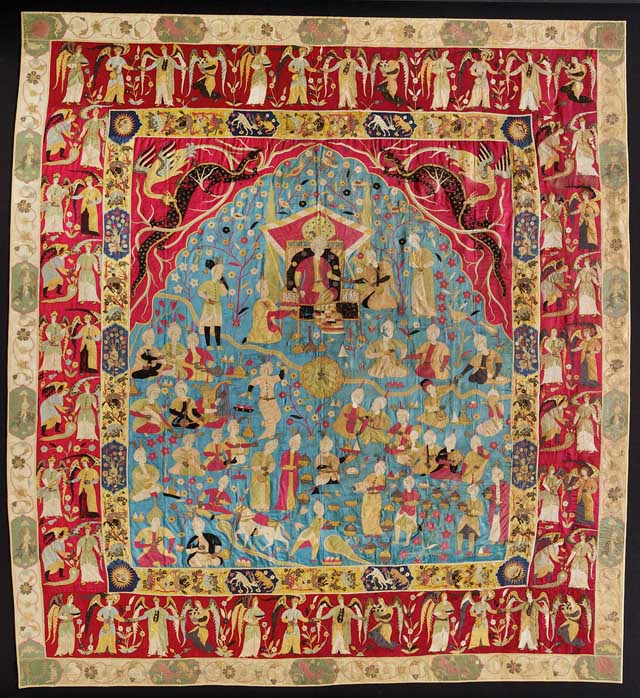
Safavid wall hanging (Cat. 14)
Iran, Tabriz (?), 16th century
Satin silk ground; appliqué of polychrome silk taffeta and gilt silvered leather; contouring of twisted red silk cord; Indian ink drawing
L: 278 cm, W: 254 cm
This truly unique Safavid silk appliqué wall hanging, the only Persian piece in the Esterházy Collection, is known as “The Budapest Appliqué.” The latest research locates its place of manufacture to Tabriz, the court of Shah Tahmasp I.
The square-shaped wall hanging has a multi-figure scene in a lobed arch mihrab in the central field: a young sovereign – probably Shah Tahmasp I Safavid (1524–1576) – sits on a sumptuous throne and joins in the revels with guests of his court.
We have no information about the original function of the appliqué or how and when it came into the Esterházy collection. The sources refer to it as a colored satin hanging or satin carpet. Its origin is mentioned only once, in 1693, as Turkish. It is usually dated to the middle or late 16th century or the first half of the 17th century. Some researchers trace it to the Sárvár treasury of Count Ferenc Nádasdy; others think it belonged to the Thököly family; a recent suggestion is that it came into the treasury after Miklós Esterházy’s victory at Érsekújvár (now Nové Zámky, Slovakia) as the ransom for a high-ranking Turkish captive in 1623.
Inv. no. 52.2801
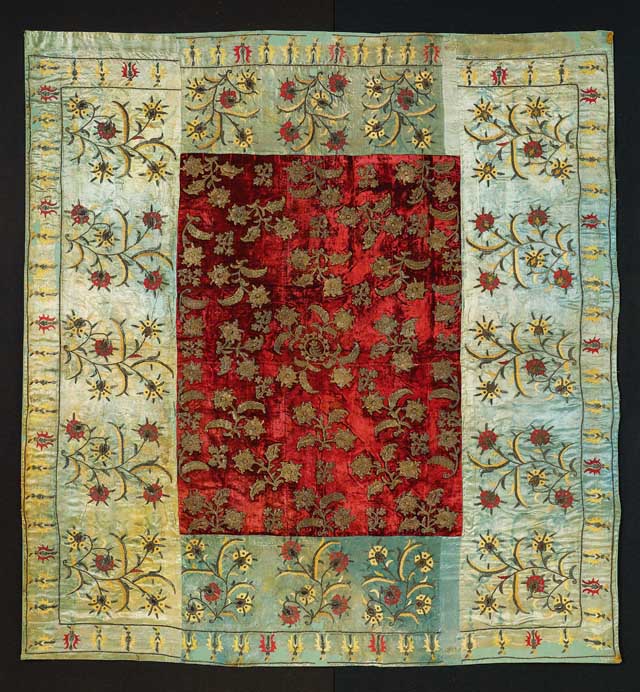
Bed cover with Báthory coat of arms (Cat. 15)
Transylvania, first quarter of 17th century
Velvet, atlas silk; silk and gilded silver thread embroidery
L: 202 cm, W: 191 cm
A distributed floral pattern on the red velvet center of the bed cover is made up of alternating large and small flower stems. The distributed floral pattern is very rare in Hungarian embroidery; alternating large and small motifs are an oriental trait. The border is decorated with flower stems of the same pattern but in differing color schemes. This, together with the outer strip of pomegranates having identical designs but two different colors, is characteristically Turkish embroidery.
The origin of the bedcover is unknown, but it may have been taken by Anna Báthory (1594–1636) when she went to the court of Miklós Esterházy in Kismarton (today Eisenstadt, Austria), later passing into the treasury after her death.
Inv. no. 52.1384.1
 Pay attention to us
×
Pay attention to us
×